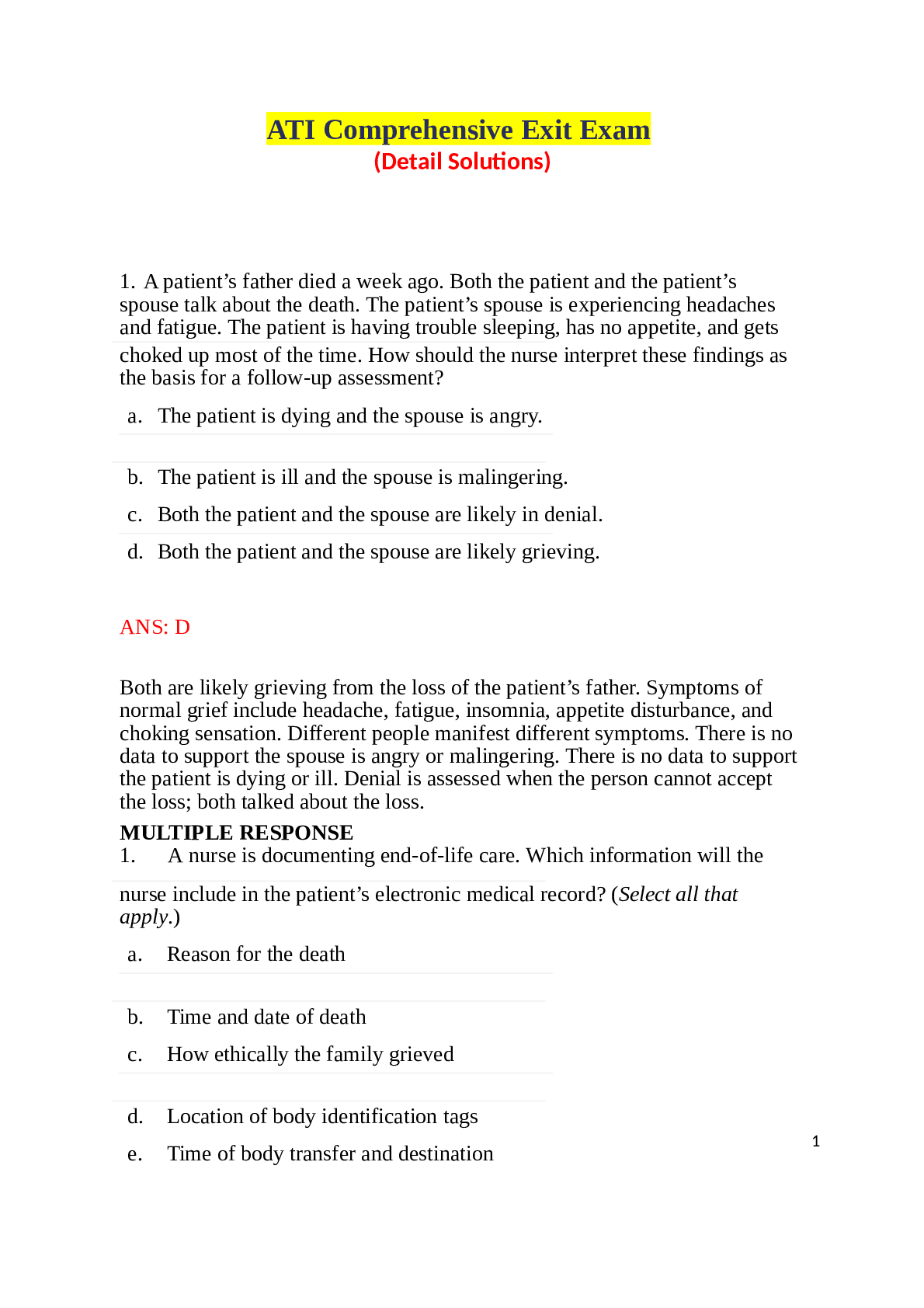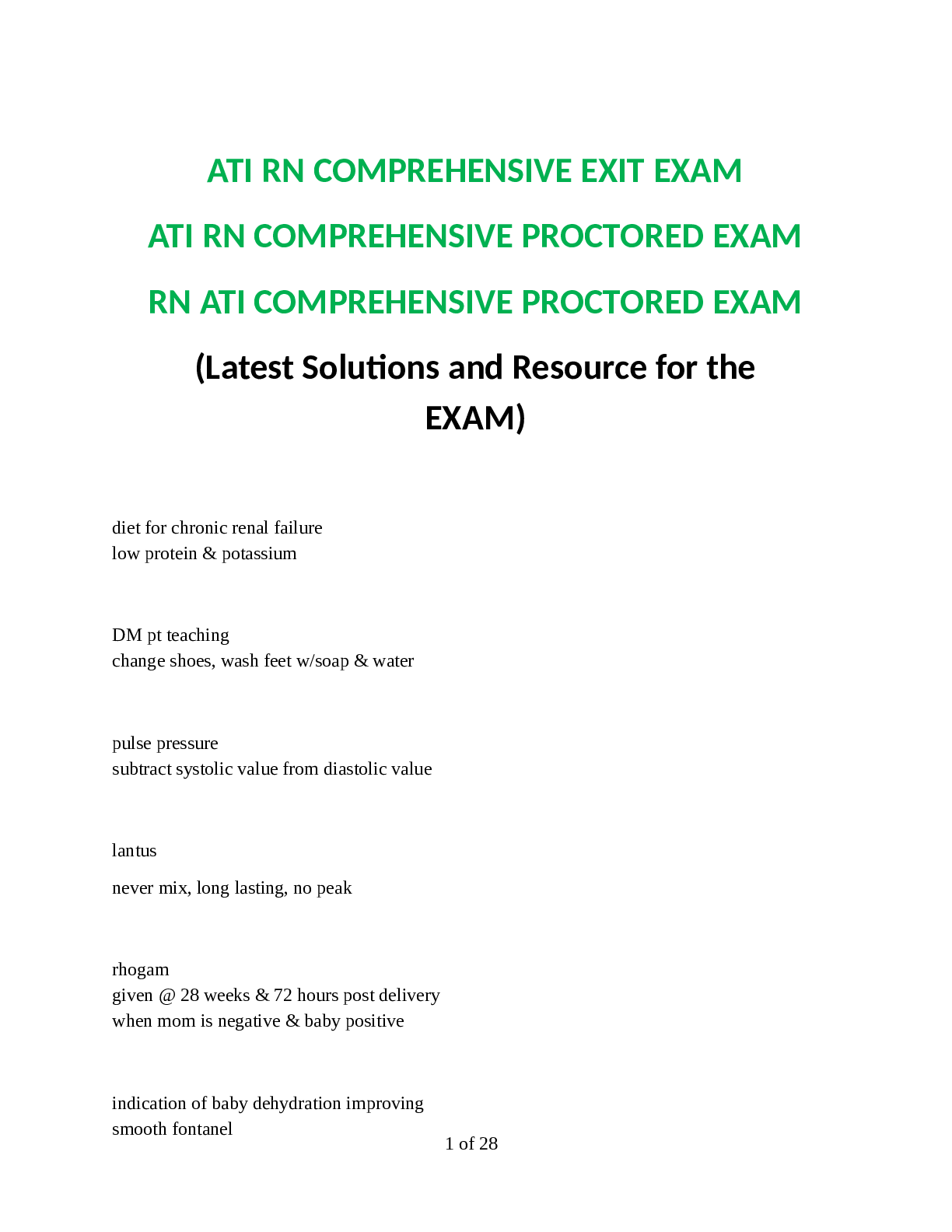*NURSING > ATI MEDICAL SURGICAL > ATI Comprehensive Exit Exam (Detail Solutions) 2021 (All)
ATI Comprehensive Exit Exam (Detail Solutions) 2021
Document Content and Description Below
1. A patient’s father died a week ago. Both the patient and the patient’s spouse talk about the death. The patient’s spouse is experiencing headaches and fatigue. The patient is having troub... le sleeping, has no appetite, and gets choked up most of the time. How should the nurse interpret these findings as the basis for a follow-up assessment? a. The patient is dying and the spouse is angry. b. The patient is ill and the spouse is malingering. c. Both the patient and the spouse are likely in denial. d. Both the patient and the spouse are likely grieving. ANS: D Both are likely grieving from the loss of the patient’s father. Symptoms of normal grief include headache, fatigue, insomnia, appetite disturbance, and choking sensation. Different people manifest different symptoms. There is no data to support the spouse is angry or malingering. There is no data to support the patient is dying or ill. Denial is assessed when the person cannot accept the loss; both talked about the loss. MULTIPLE RESPONSE 1. A nurse is documenting end-of-life care. Which information will the nurse include in the patient’s electronic medical record? (Select all that apply.) a. Reason for the death b. Time and date of death c. How ethically the family grieved d. Location of body identification tags e. Time of body transfer and destination 1 ANS: B, D, E Documentation of end-of-life care includes the following: time and date of death, location of body identification tags, time of body transfer and destination and personal articles left on and secured to the body. Reason for the death is not appropriate; this is a medical judgment and not a nursing judgment. How ethically the family grieved is judgmental and does not belong in the chart. We must remain open to the varying views and beliefs of grieving that are in contrast to our own in order to best support and care for our patients and their families. Week 3 Safety and Fall Prevention among Older Adults, Preventing Complications of Immobility 1. A home health nurse is performing a home assessment for safety. Which comment by the patient will cause the nurse to follow up? “Every December is the time to change batteries on the carbon a. monoxide detector.” b. “I will schedule an appointment with a chimney inspector next week.” c. “If I feel dizzy when using the heater, I need to have it inspected.” d. “When it is cold outside in the winter, I will use a nonvented furnace.” ANS: D Using a nonvented heater introduces carbon monoxide into the environment and decreases the available oxygen for human consumption and the nurse should follow up to correct this behavior. Checking the chimney and heater, changing the batteries on the detector, and following up on symptoms such as dizziness, nausea, and fatigue are all statements that are safe and appropriate and need no follow-up. 2. The nurse is caring for an older-adult patient admitted with nausea, vomiting, and diarrhea due to food poisoning. The nurse completes the health history. Which priority concern will require collaboration with social services to address the patient’s health care needs? a. The electricity was turned off 3 days ago. b. The water comes from the county water supply. 2 c. A son and family recently moved into the home. d. This home is not furnished with a microwave oven. ANS: A Electricity is needed for refrigeration of food, and lack of electricity could have contributed to the nausea, vomiting, and diarrhea due to food poisoning. This discussion about the patient’s electrical needs can be referred to social services. Foods that are inadequately prepared or stored or subject to unsanitary conditions increase the patient’s risk for infections and food poisoning, and an assessment should include storage practices. The water supply, the increased number of individuals in the home, and not having a microwave may or may not be concerns but do not pertain to the current health care needs of this patient. 3. The patient has been diagnosed with a respiratory illness and reports shortness of breath. The nurse adjusts the temperature to facilitate the comfort of the patient. At which temperature range will the nurse set the thermostat? a. 60° to 64° F b. 65° to 75° F c. 15° to 17° C d. 25° to 28° C ANS: B A person’s comfort zone is usually between 18.3° and 23.9° C (65° and 75° F). The other ranges are too low or too high and do not reflect the average person’s comfort zone. 4. A homeless adult patient presents to the emergency department. The nurse obtains the following vital signs: temperature 94.8° F, blood pressure 106/56, apical pulse 58, and respiratory rate 12. Which vital sign should the nurse address immediately? a. Respiratory rate b. Temperature 3 c. Apical puls [Show More]
Last updated: 2 years ago
Preview 1 out of 27 pages

Buy this document to get the full access instantly
Instant Download Access after purchase
Buy NowInstant download
We Accept:

Reviews( 0 )
$10.00
Can't find what you want? Try our AI powered Search
Document information
Connected school, study & course
About the document
Uploaded On
Aug 26, 2022
Number of pages
27
Written in
Additional information
This document has been written for:
Uploaded
Aug 26, 2022
Downloads
0
Views
171






